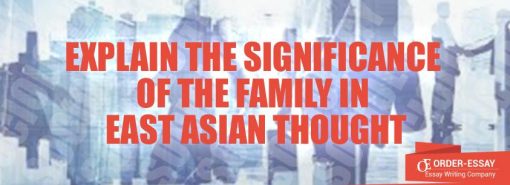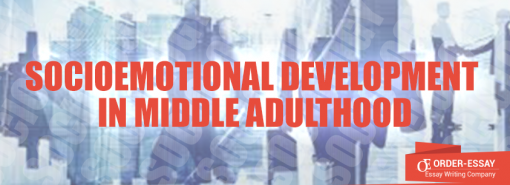
Introduction
East Asia comprises of several countries that uphold almost similar values in regard to their perception about family. The countries that constitute East Asia include Vietnam, Indonesia, Malaysia, China, and Singapore. In the East Asian thought, several elements constitute a family unit, and they have specific significance about their impact on members of the family and society (Yao 25). The various traditions and heritage adopted by various families in the East Asia undergo great influence of Confucianism. The family values and traits that arise from various beliefs of Confucianism include the respect accorded to family and the elders. The relationships greatly fostered in the majority of the East Asian families were the friend-friend, elder brother-younger brother, husband-wife, and father-son ruler-subject type of relationship. Various teachings arose based on respect to the elderly. It was upon these social structures that the families of East Asia gained and played specific roles in character shaping of the individuals in the society (Yao 130). The society was able to progress because it bore its roots from the family structure and education that taught to its respective members. Various elements of collectivism, hierarchy, face, harmony in existence and social reciprocity are discussed in order to show the significance of the family in the East Asian thought. The discussion aims at finding out whether the East Asian family set-ups had an impact on the growth and development of individuals and the society.
Collectivism
The traditional Asian family therefore was comprised of various characteristics that governed the operations and management in the society in which family members resided. In particular, the existing hierarchical structure consists of the older people in the society who form the top of the structure. In addition, they are accompanied by males who are regarded as members of a higher status that the females in the society. There existed various gender differences between the Asian female and the Asian male. Baby boys are highly valued in the Asian family, and societies believed them to be the holders of the family name and traditions (Chan and Joseph 132). The family name transited from various lineages that existed and passed from generation to generation.
The feminine members of the society had various roles and responsibilities. They had a duty and obligation to obey and adhere to the rules and commands directed to them by their husbands. The feminine members of the society were valued less than the males, and they had a more passive role in the society. Apart from being submissive to men, they were also involved in various other responsibilities such as the performance of various domestic chores and rearing of children. Males provided for the family needs and carried out various responsibilities that the society expected them to uphold. The expectation attributed was to be diligent and good sons to their parents and the elders. The expectations also included kindness and love to their families as a father and as a husband to the women in that particular society. There was a patriarchal relationship between the husbands and their wives. The family was brought up with a belief that they were to respect the elderly and the ancestors since they formed a part of the family structure (Yao 137). The society referred to them for wiser council in matters that required grave decision making and critical thinking.
Hierarchy
There was extreme loyalty accorded to the people who were in authority. They were the leaders of the community who commanded and derived respect since they occupied places of power and influence in the society. In the family setting, there was only one way of communication fostered and established. The adults could speak to the junior members of the society. It was designed to increase respect to them that already existed in that particular society. There was an element of collectivism. It mainly focused on the groups and families that existed in the society. The elderly in the society taught children and young adults about interdependence. The teachings made them utterly believe that the family formed the central organ in the society (Chan and Joseph 138). It existed as the primary unit to which the majority of things were attributed. The behavior of a particular individual reflected various family attributes that existed in the society. If a member of the family developed characteristics such as gross misconduct, then the family which the individual originated from received the blame. There is a belief that the values and traditions of a particular family were a reflection of individuals’ character and behaviors.
Face
The family instigated discipline among the various members in the society. The principle of guilt and shame acquired a status meant to correct an individual’s behavior. An individual found in gross misconduct would be publicly condemned and humiliated. It therefore acted as a lesson and a warning to other individuals who intended to engage themselves in various gross misconducts. Emphasis on honor and loyalty to the family become a fundamental component of the lives of the members in the society (Yao 145). It was the main tool for one to avoid being ashamed and embarrassed in the family. Any rifts and misunderstandings between the various families underwent private concealment from the society. Family problems become manageable within the family without the involvement of any external members of the society.
Achievements by various members of the society always boiled down to the family. The family took pride in the achievements of its members. Most of pride always resulted from various academic successes of the children that existed in the particular family setting. However, there were certain events that remained shameful in the society. Some of the things not taken lightly by the family were the psychotic state of an individual family member. Mental illness was a big shame to the family. It was a major setback and failure of the family (Chan and Joseph 148). Family members who were mentally ill underwent mistreatment and were viewed as outcasts in the society. They were separated from society and humiliated because they carried the shame of the family.
Social Reciprocity
There was a limited open display of love and affection expressed by the members of the family or the community. It represented a sign and symbol of self-control and maturity. It was a sign of respect to the various members of the society ranging from the young children to the mature and elderly in the society. During the supply of various physical needs and desires to various members of the family, caution and care were always used. There were certain ways in which the mother and father of a home had expectations of behavior relative to the preservation of their various roles and responsibilities (Yao 152). The father was a distant and authoritative figure. He demonstrated less emotion and did not involve himself in matters of love and affection. He stuck to the role as the sole provider for the family. There were also various expectations of the mother in respect to the matter. The mother was more responsive to children. However, she deviated from deeply nurturing a child. She was verbal. She would easily provoke an individual to resort to punishment that is more physical. She was responsible for meeting the emotional needs of the children and served as an intermediary between the child and the father. It was not a common occurrence for the father to interact with a child. In addition, it was relative to the situation and occurrence of various events. For instance, if a child looked down on the mother when the father came in, it would result in a very serious punishment.
Harmony
The family reared a sense of pride in belonging to the family. It was bred from obedience, honesty, diligence and hard work. The economic status of the family was very important. It was upon the male members of the society to put their families at a specific social and economic status from which their happiness and confidence derived. The various achievements that a family member achieved in the society was all attributed to the existence of hard working individuals in the society (Goldin 165). Such families were always valued, and the majority of leadership positions were available for well-educated families that achieved a certain social and economic strata. While the marriage traditions were governed by male dominance, it formed the essential structures that promoted continuity in the family. The value of male gender in the society was something that majority of individuals took pride of. However, these traditions were not always the same in various East Asian states. Nonetheless, the basic common goals and fundamentals were the same. Respect and honor derived from these factors.



Change and Tradition in the Family Life in Relation to Marriage
There has been a change in the ways and trends that related to family life and marriage. In the present day society, the majority of young people are getting married at a tender young age. The couples have a restriction on the number of children that they have. The family structure has undergone alteration since it consists of various families headed by single mum parents. Many mothers have also neglected their families because of work related activities. The family was viewed as a responsive unit that comprised of a man, his wife, several sons, and a few daughters (Yao 160). Such family structure remained to exist for a very long time. A man managed a specific type of household and derived respect from the members of the society. It also made him able to sit in the council of the elders and advise the various rising couples on the importance of life and other family values. They were great reference points asked for their respective successes in life.
Get a Price Quote
Conclusion
In the lives of most of people in East Asia, the family derived from the majority of responsibilities and careers. Families including an extended family were expected to live in unity and harmony with each other. Various roles and responsibilities of family members were defined and the children were taught how to interact with each other at various stages in their lives. They were educated on the values and attributes of living in peace and harmony. They learnt about respect and lived in harmony. The relatives taught how to co-exist and even help those who were not able to fend for themselves in the society such as the aged and elderly. The introduction of the extended family was a much stronger union as opposed to the single unit family that comprised of the basic elements of family. The basic nuclear family lacked the majority of things that were relevant for the growth and development of children in the society. It also deprived parents of the ability to interact with other people in the society. They developed characteristics of people who were neglected. The children brought up in this setup are usually afraid of interacting with other members of the society. It becomes necessary to define the components of a family and create metrics in order to know the origin and foundation of the family.
It should, however, be recognized that the perspective of a woman in the society is drifting slowly from being oppressed and governed by the society to gaining independence and ability to make decisions on her own. The family, therefore, has a great impact on the lives and relations of people in East Asian families. It is a source of strength and courage for the majority of members of the society.








